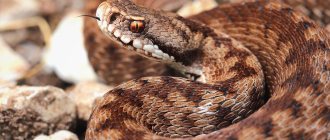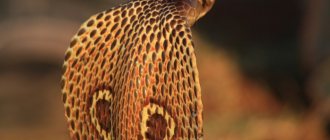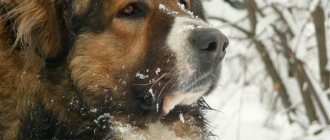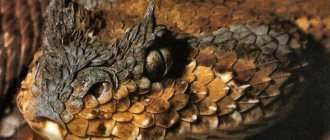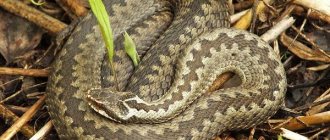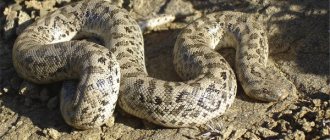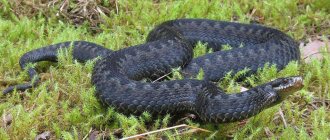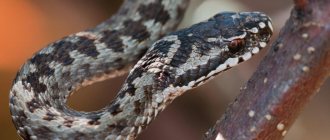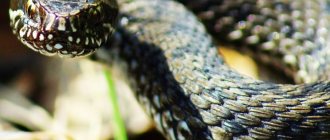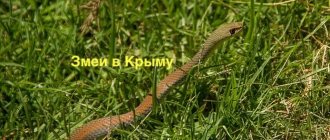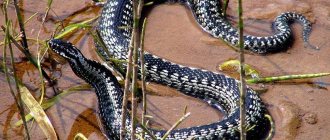Kaznakova's viper, or Caucasian viper (Vipera kaznakovi) - the brightest and most beautiful viper of all species of this genus living in our country. It was described at the very beginning of our century by the famous Russian zoologist, Professor A. M. Nikolsky and named by him in honor of the deputy. Director of the Caucasian Museum A. N. Kaznakov. The habitat of this rare snake stretches along the Black Sea coast, covering the forested foothills of the Caucasus up to 800 m above sea level, from the village of Khopa in Turkey and the Suram Pass in the east through Colchis to the Mikhailovsky Pass in the west, where it passes to the northern slope of the Greater Caucasus and along the foothills stretches to the village of Ubinskaya in the west to Maykop in the north and the mouth of the Urushten River in the east. In general, the range of the Caucasian viper is represented by two fragments, Adzhar-Lazistan (Turkey, Adjara) and North Colchis (western Georgia, Abkhazia and the Krasnodar region of Russia). Kaznakov's viper forms at least 5 subspecies.
Origin of the species and description
The Caucasian viper belongs to the vertebrate reptiles, separated into the order Scaly, suborder of snakes, family and subfamily of vipers, genus of true vipers, species Caucasian viper.
This snake has many names. One of them is Kaznakov’s viper. It is under this name that zoologists define it. That’s what Russian researcher A.M. called it. Nikolsky. He was the first to describe it back in 1909. He named it in honor of the famous naturalist and explorer Kaznakov, who was a model and example for Nikolsky. The snake is also often found under the name of the chess viper. This is due to the checkerboard pattern on the viper’s body.
Video: Caucasian viper
Snakes are considered to be very ancient creatures. The first reptiles appeared on our planet from 200 to 250 million years ago. Scientists believe that they appeared in the Triassic period, and are the same age as dinosaurs. The first snakes had limbs. However, a large number of enemies forced them to hide in the ground. The limbs created great difficulties, so later in the process of evolution the forelimbs disappeared. The hind limbs remained, but over time they became much smaller and became like small claws that are located at the base of the tail part of the body.
The snake finally lost its limbs about 70-80 million years ago. Many scientists also assumed that the ancestors of snakes were large lizards, presumably geckos. Among all the reptiles existing on earth, they have the maximum resemblance to snakes. In the process of evolution, snakes divided into species and spread to different parts of the world. Viper snakes number about 50-60 species.
The snake with many names
It’s worth starting with the fact that this snake has many names and names. For example, for the inhabitants of the mountains it is simply a Caucasian viper, the poison of which can cause them a lot of trouble. And therefore, both large and small residents of the Caucasus know about it.
But for zoologists, the more familiar name is “Kaznakov’s viper.” Amazing name, isn't it? But this is exactly what the Russian researcher A.M. Nikolsky dubbed it, who, in fact, discovered this species in 1909. The name of the snake is associated with the great naturalist of that time, A. N. Kaznakov, who was an idol for Nikolsky.
This snake is also known as the Caucasian chess viper. This name is due to the fact that it has a characteristic skin pattern. Therefore, you should not be surprised that in different circles this bright reptile can be “magnified” in different ways. In reality, this is the same snake.
Appearance
It should be noted that nature gave this reptile amazing camouflage. It is able to change depending on where the viper lives. And, despite the fact that its color is dominated by bright colors, it is almost impossible to notice it in fallen leaves or grass. Lowland species often have dark orange or red skin color. But rock lovers, on the contrary, change their color to a darker side, sometimes transforming it into black. Sometimes on the back of the reptile there is a stripe of yellow or red color that runs through the entire body of the snake.
With age, colored pigments cover almost the entire body of the viper, which gives the impression that they are laid out in a checkerboard pattern. That is why it is also called chess. If we talk about the size of the snake, then it rarely grows in length more than 70-80 cm. At the same time, the females outnumber the gentlemen in their proportions by about 10-15 centimeters. Like other species of snakes, the head of the Caucasian viper stands out strongly against the background of the body and is shaped like the tip of a spear.
Poisonous snakes
Dangerous and poisonous representatives of the suborder from the class Reptiles and the order Squamate are found almost everywhere in the Caucasus. Moreover, individual specimens of the most common species can reach a length of two or more meters. Venomous snakes thrive in a wide variety of environmental conditions, including forest areas, steppes and deserts, as well as foothills and mountainous areas.
The viper is real
True vipers are usually small in size. The head, spaced from the neck, is covered with rather small scales, but some specimens are characterized by the presence of small scutes. The venom of such a snake is the most toxic for humans, causing very sharp and rapidly increasing pain and the appearance of severe swelling at the site of the bite. Within two hours, vascular inflammation develops, and after a couple of days, hemorrhagic blisters form. Such a dangerous reptile prefers rotten stumps, burrows of other animals and bushes, and any sudden movements are regarded by the viper as a provocation and cause aggression.
Common viper
Representatives of the species have a flat head, noticeably different in size from the average thickness of the body. Most individuals are characterized by the presence of a zigzag pattern along the ridge. The result of a bite from a common viper is extremely rarely fatal, but there is a certain danger of the venom of this snake for humans. In medical practice, there are well-known cases of complete absence of severe symptoms in people who have been bitten, but most often the result of a bite is dizziness and vomiting, convulsions and loss of consciousness. Common vipers live in cool places and also inhabit mountainous terrain.
Steppe viper
The large snake has a body length of about 55 cm with a tail length of 7-9 cm, but females are most often noticeably larger than males. The rather slow viper is distinguished by a slightly elongated head and raised edges of the muzzle. On the upper surface of the head there are small, irregularly shaped scutes. Such typical inhabitants of mountain and lowland wormwood steppes are excellent swimmers, but quite often climb bushes and tree branches. The steppe viper is a venomous snake, but deaths are rare. Most often, under the influence of poison, a state of general intoxication develops.
Dinnika's Viper
The snake, which received its name in honor of the famous domestic zoologist Nikolai Yakovlevich Dinnik, is characterized by a rather unusual color. Against the background of the gray-green back there is always a pronounced lemon-black pattern. The average length of adult specimens rarely exceeds 50-55 cm. Between the large frontal and supraorbital shields there is one or a pair of rows of small scales. Snake venom is very toxic to humans. An attractive habitat for the Dinnik viper is landscapes represented by subalpine meadows, as well as forests with areas of stable daytime coolness.
Gyurza
A special feature of the viper is its body length, often reaching two meters. The body is predominantly dark gray, black or black-violet in color, with a light belly and a thin neck area. The largest representative of all the snakes of the Caucasian fauna poses a very serious danger to people, which is due to the strong poison introduced into the human body during the bite process. Death occurs within a couple of hours. At the same time, an attacking snake can easily cover two meters when thrown. The natural habitat of the viper is rocky streams and mountain slopes, abundantly overgrown with bushes.
Tiger snake
This amazingly colored representative of the scaly snakes of the North Caucasus belongs to the category of “conditionally poisonous” snakes. The brindle snake has well-defined bright green skin interspersed with red and bright orange. The average length of an adult snake rarely exceeds 100-110 cm. The bite of this small reptile is accompanied by very severe bleeding, which is due to the large size of the pair of maxillary teeth. Representatives of the species are known for their manner of imitating a poisonous cobra. The tiger snake flattens its neck into a hood and raises the front part of its body above the ground.
Cottonmouth
The seventy-centimeter poisonous snake has a brown general background of the body, on which gray transverse spots located along the ridge are clearly visible. The bite of the copperhead is extremely painful and dangerous to humans. As a result of intoxication, numerous hemorrhages appear in the internal organs. Among other things, the bite of this snake can provoke the development of local paralysis or necrosis. Under natural conditions, copperheads live in steppes and forests, and are also found in rocky areas and lower reaches of rivers in the North Caucasus.
Return to content
Lifestyle
Kaznakova's viper is a diurnal predator. Having warmed up well in the sun, she goes hunting for mouse-like rodents, lizards, frogs and birds. A person should be especially careful, because the bite of the Caucasian viper is fatal. Around the end of March, when the soil surface warms up to +16–17 °C, Kaznakov’s vipers emerge from hibernation.
The period of their activity lasts until November, during which time they need to gain strength for the upcoming winter and give birth to offspring. The mating season falls in March - April, and young individuals are born only at the end of August. Like all representatives of its genus, Kaznakova’s viper reproduces by viviparity. A litter averages from three to eight baby snakes. After birth, the cubs are active for about 1.5–2.5 months, and then, obeying natural instinct and environmental conditions, they fall into hibernation. When going for the winter, vipers choose suitable burrows and crevices, climbing to a depth of about 2 m from the soil surface. The diet of adult snakes is dominated by rodents and lizards, but young of the year are left with mostly insects.
Brittle spindle or slow spindle
If she could, she would tell everyone: I’m not a snake, but a legless lizard, and I’m absolutely harmless! The differences between this snake-like lizard and a snake are quite significant. It is also capable of dropping its tail and blinking its eyelids, just like lizards. Having no scales on the underside of the body, the copperhead will move in a figure of eight on a forest path, and not in a “flat line” like snakes, which rely on their scales when moving. If you look closely at it, you will notice that the spindle is like a plasticine sausage and does not have a clearly defined neck line.
Popular habitats of the Caucasian viper
The Caucasian viper can live in almost any region of the world, regardless of its climatic conditions. Main habitats of the reptile:
- some areas of Turkey;
- Asian countries;
- Abkhazia;
- Georgia;
- Caucasus mountains;
- regions of North and South America;
- Europe;
- Australia and New Zealand.
The favorite habitat for the chess viper is mountainous areas, forests, ravines and plains, fields and bushes, especially often those located near water bodies. During the daytime, they hide in mown grass and tall thickets.
Every year the population of chess snakes is rapidly decreasing. Quite often they can be found in the immediate vicinity of settlements, where they crawl in search of food. Such a “neighborhood” poses a huge danger not only to health, but also to human life.
Habitat
As mentioned earlier, the Caucasian viper is a rather rare species. And you can only find it in the area of these mountains, as well as in the territories adjacent to them. So, the homeland of the reptile we are considering is the Greater Caucasus, stretching through Abkhazia, Georgia and part of Turkey.
At the same time, vipers try not to crawl to a height of more than 800 meters above sea level. Although a few decades ago scientists believed that they also live in higher elevations. But, as it turned out, the reason for such a misunderstanding was another snake, similar to the Caucasian viper, but with a number of specific differences.
What does the Caucasian viper eat?
The viper is a venomous reptile and therefore a predator. The main source of food is rodents and small invertebrates. The snake is a skilled hunter. She prefers to hunt at night. The snake hides in ambush and waits patiently. When the prey gets as close as possible, it rushes at it with lightning speed and sinks its fangs with a poisonous secretion. The victim dies within a few minutes. After this, the chess viper begins eating, swallowing the prey whole. The digestion process takes several days.
What is the food supply:
- small rodents;
- lizards;
- lizards;
- frogs;
- shrews;
- jerboas;
- small birds;
- various types of insects - locusts, beetles, caterpillars, butterflies.
The Caucasian viper has a simply brutal appetite. She can eat many times her weight. For this reason, she has to spend a huge amount of time in ambush waiting for prey.
The tool for successful hunting is a well-developed sense of smell. The main tool for hunting is a forked tongue, which the snake constantly sticks out. The reptile slowly crawls along the trail. With her tongue she lightly touches the surface of the ground where the victim passed. She then places the ends of the tongue into the Jacobson's organ, which is located in the upper palate. Next, the received information is processed, which allows snakes to determine as accurately as possible how far away the prey is and what size it is.
The chess viper has a very complex venomous apparatus. It includes sharp poisonous teeth and glands that produce a super-powerful poisonous secretion. The teeth are located on the short maxillary bone. Thanks to this structure of the oral apparatus, the upper jaw opens almost 90 degrees, while the teeth stand in a vertical position. Viper venom is very toxic. It causes extremely painful sensations, swelling and redness of the bite site. The poison immediately enters the lymph nodes and spreads throughout the body, destroying red blood cells.
What to do when meeting a snake
Snakes have rather poor hearing and vision. In the world around them, such reptiles are able to navigate mainly by smells, or rather by the taste characteristics of the air. For this purpose, snakes constantly stick out their tongues. Representatives of the order Squamate hear noise with their whole body, sensing soil vibrations. When you meet any snake, you don’t need to touch it or try to catch up with it: if you see it, go around it. In potentially dangerous areas, you can move only in closed, preferably sufficiently high and durable shoes.
It is recommended to avoid holes or ravines, as well as any other low-lying areas overgrown with too thick and tall grass. It should be remembered that places greasy with rodents are especially attractive to snakes. When traveling and hiking, it is highly undesirable to arrange rest stops and overnight stays near trees with hollows, near rotten stumps, or near entrances to crevices or caves. When going to bed, it is important to make sure that there are no reptiles in the bed or sleeping bag.
When meeting a snake, you need to remember that such reptiles try to avoid an open collision with an enemy that is superior in strength and size. Sometimes it is enough to simply stomp or tap some object on the ground to scare away a representative of the scaly ones. An attack can be provoked by the desire to touch the snake or take a photo with it. According to experts, in most cases, snakes attack a person only in cases of extreme necessity, most often for the purpose of self-defense.
How dangerous is the venom of this reptile?
The bite of the Caucasian viper is fatal to many animals. The thing is that the toxins that enter the bloodstream along with the bite have a detrimental effect on the victim. After a few minutes, the poison begins to corrode the blood vessels in the body, which leads to internal hemorrhages. Small creatures die quite quickly, but larger ones have to suffer for some time.
If we talk about humans, then for him the poison of the Caucasian viper, fortunately, is not fatal. However, this does not mean that it cannot lead to serious complications. Therefore, it is very important to seek help from a doctor if an accident does happen, and the sooner this can be done, the better. It should be noted, however, that this type of viper rarely attacks humans. In general, if you do not provoke the snake, it will not attack first. Moreover, in most cases, she would prefer to crawl away rather than start fighting a large enemy.
If a snake bites
If a snake accidentally disturbed by a person attacks, then a bite of a poisonous species can be distinguished from a safe one by the characteristics of the mark left on the skin. When bitten by a poisonous snake, a sufficiently deep puncture is formed from a pair of teeth. Non-poisonous reptiles leave a mark in the form of two rows of small and barely noticeable punctures or a couple of scratches. Such bites, as a rule, do not pose a serious danger, but the wounds must be treated with any antiseptic composition, and then protected from external influences with a plaster.
When bitten by a viper, viper or copperhead, it is necessary to provide complete rest to the affected limb, which will slow down the spread of toxins throughout the body. The poison is squeezed out of the wound immediately after the bite, and if necessary, the wound is widened, making it possible to remove a significant part of the dangerous toxin through the blood. Then the bite site is thoroughly disinfected with an antiseptic and a sterile bandage is applied. The victim should be taken as quickly as possible to the nearest medical facility, where a full range of medical care will be provided and a special, highly specialized antidote will be administered.
Return to content
In the Red Book of Russia
Among the species included in the Red Book of Russia, there are animals that are truly extremely rare to encounter. These include Kaznakov's viper, or Caucasian viper. This is a rare, declining species that lives in our country on the northern periphery of its range.
Kaznakova's viper is unique because it is a relict endemic of the Western Caucasus. Economic development of land, reduction of protected areas, disturbance from tourists are the most serious threat factors for this species. Kaznakov's viper is also included in the International Red List.
The total area of the viper's range does not exceed 500 km2, and it is constantly fragmenting. According to experts, if the current state of affairs continues in the future, then in the next 10 years the number of the species will decrease by 50%. In Russia, the Kaznakova viper is protected in the Caucasus Nature Reserve and in the Sochi Natural National Park. The snake received its specific name in honor of the deputy director of the Caucasian Museum A. N. Kaznakov.
Common copperhead
A medium-sized snake up to 70-80 cm. In the classic version, its upper body is reddish-brown with a metallic tint. A dark stripe runs along the upper back. Often found on sunny and dry forest paths throughout the Sochi National Park. In April-May they begin the mating season, and at this moment she becomes more active, especially if you want to push her away with your foot, she may try to bite. An allergic reaction may occur to its bite, with all the consequences: swelling, pain. And even a rise in temperature. Therefore, it is always better to bypass any snake in your path and not disturb it. The forest is their home.
Thracian yellowbell or capercaillie
Another legless lizard. A relic of the xerothermic period (post-glacial period). In fact, he has no paws - only barely noticeable rudiments of the hind limbs remain. The yellowbell differs from snakes by the presence of ear openings and movable eyelids, like all lizards. Adult yellowbellies are yellow or brown in color, the underside of the body is lighter than the top. Young yellowbellies are completely striped, the stripes are transverse and zigzag. The size can reach half a meter.
Most often, the yellowbell is found in the Lazarevsky and Khostinsky districts. Last year, a rather large but friendly yellowbelly settled in the Arboretum. With its size, of course, it sometimes frightens visitors, but it is a very useful legless lizard that helps maintain the natural balance by eating small plant pests: locusts, snails, beetles. But if possible, he will not refuse sweet fruits and bird eggs. In the hottest months, unlike snakes, they can hibernate, and summer hibernation often turns into winter, from which yellowbellies emerge only in March-April at the beginning of the mating season.
Social structure and reproduction
The mating season for snakes begins with the onset of spring.
Interesting fact: This type of viper does not lay eggs, like other snakes, but gives birth to fully formed offspring. The formation of eggs and the hatching of young ones from them occurs internally. Viable and fully formed individuals are born.
The period of birth of offspring occurs at the end of summer or beginning of autumn. One viper can give birth to 7 to 12 cubs at a time. The birth process occurs in a rather unusual way. The female wraps herself around a tree, leaving her tail part in a canopy, and literally throws her cubs onto the ground. The small snakes that are born reach 10-13 centimeters in length. Most often, small snakes are light gray or light brown in color with a pattern characteristic of this type of snake. After birth they immediately moult. Subsequently, molting occurs on average twice a month.
Vipers that live in mountainous areas give birth once every two to three years. Female chess vipers are not particularly affectionate towards their offspring. On the second day after the birth of the offspring, small snakes crawl in different directions.
Yellow-bellied snake (Caspian)
The largest snake in Europe. Reaches up to 2 m. It is notable not only for its impressive size, but also for its aggressive disposition. It can attack and bite a person, although it is harmless. This snake prefers dry and open places. Quite often found in the foothills of the Khostinsky district. Summer residents have seen this snake on their property more than once. They love to crawl into outbuildings or hide in thick thickets of grass. Yellow-bellied snakes are very attached to their shelters and constantly return to them, even after moving considerable distances.
Natural enemies of Caucasian vipers
Despite the fact that the chess viper is considered dangerous and very poisonous, it has many enemies in its natural habitat.
Enemies of the Caucasian viper in the wild:
- foxes;
- ferrets;
- copperheads;
- wild boars;
- some types of large feathered predators - owls, herons, storks, eagles;
- hedgehogs
It is noteworthy that hedgehogs do not eat dangerous, poisonous snakes, but simply fight with them. In most cases, it is hedgehogs who defeat the insidious poisonous reptiles. Surprisingly, toxic snake venom also does not have any harmful effects on wild boars.
Humans should also be considered among the enemies of chess snakes. People hunt snakes for valuable snake skin, meat and toxin. In alternative medicine in many countries, in particular in the countries of East Asia, a large number of all kinds of ointments, lotions, and creams are made based on snake venom. It is also widely used to make antidotes.
In many countries, the meat of poisonous snakes is considered a very rare and incredibly expensive delicacy. Many gourmets in eastern countries prefer to eat dried meat of the Caucasian or chess viper.
Features of character and lifestyle
Photo: Poisonous Caucasian viper
The viper is a poisonous snake. She tends to lead a solitary lifestyle, or in a couple. Mainly nocturnal. During the day it mostly lies down in a secluded place. When darkness falls, he goes out hunting. Vipers spend a significant part of their time searching and catching food.
This type of reptile leads a territorial lifestyle. A single snake or a pair zealously defends its territory from uninvited guests. They wait out the winter in rock crevices or burrows. Many species of snakes die during the winter season. But vipers wait out the cold quite calmly.
Interesting fact: Caucasian vipers mainly choose burrows or crevices located at a depth of 2 meters or more as shelter for the winter period. Thus, these places are located below the soil freezing level, which allows you to withstand cold and severe frosts completely calmly.
The Caucasian viper has a large number of enemies in natural conditions. Therefore, she is extremely careful and chooses her hiding place very carefully.
Population and species status
The number of dangerous reptiles is constantly decreasing. The main reason for this situation is the development of ever larger territories by humans. This forces snakes to move further and further from human possessions, and their habitat is rapidly shrinking. Chess vipers tend to settle near human settlements. This provokes a person to exterminate snakes. Many reptiles die under the wheels of cars and agricultural machinery.
The situation is aggravated by the fact that reptiles rarely give birth to offspring. In addition, human activity, which provokes the displacement of snakes from their territory, contributes to their death. These are territorial reptiles that find it very difficult to take root in foreign, unfamiliar territory.
The decline in numbers is also facilitated by the lack of food supply. Chess vipers need a lot of food. Not all regions where these reptiles live have sufficient food supply. People destroy rodents as pests of agricultural crops. This also contributes to population decline. To date, scientists and researchers cannot determine the approximate population size.
Interesting fact
All vipers are poisonous; a person can die from their bite. However, it is worth remembering that snakes never attack first those who are much larger and larger than themselves. Vipers can bite a person solely for the purpose of self-defense. Usually animals warn about themselves in advance with a loud hiss.
Vipers have a very interesting tooth structure. On the upper jaw there are two sharp fangs connected to poisonous glands. These fangs are designed so that they can rotate, taking a vertical position if necessary. When attacking, the viper literally pierces the skin of the victim and releases poison into its body through the internal channels of the teeth.
HORNED VIPER: CONTENT IN A TERRARIUM, PHOTO, DESCRIPTION, FOOD
COMMON STROKE MOUTH: DESCRIPTION, PHOTO, LIFESTYLE, NUTRITION, REPRODUCTION
STEPPE VIPER: LIFESTYLE, POISON, PHOTO, REPRODUCTION, NUTRITION
Olive snake
A rare Mediterranean species, one of the most graceful and swift Sochi snakes. The length rarely exceeds one meter. A small head with very large and, as it seemed to us, intelligent eyes. The body color is olive, light brown, very similar to a watering hose. There are always light vertical stripes in front and behind the eyes. The belly is yellowish or greenish-white.
The olive snake not only prefers sunny places, but will also be happy to meet you among wet ferns. In the mountains it is found up to an altitude of 2200 meters.
This snake is much less aggressive than its brothers. He doesn’t hiss, doesn’t attack, and when there is danger, he will always run away first. The snake does not make any sounds at all; it is called a silent snake. If you catch a snake, it can bite, and quite painfully, since it has sharp and thin teeth. But the snake has no poison; this bite will not cause harm to humans.
